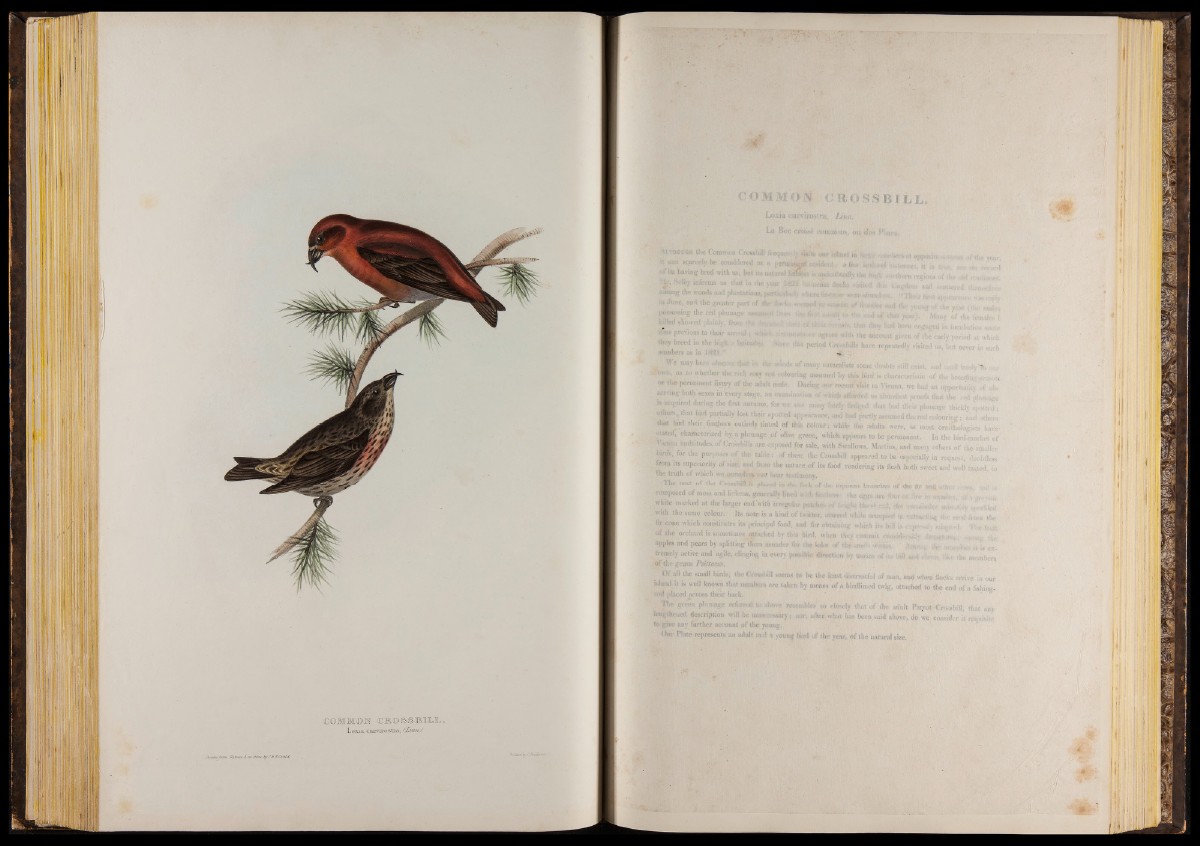
C O M M O W C R 0 S S B U . I .
Loxia curvirostra¡ fZtswuJ
OMMOJV c r o s s b i l l .
Loxia curvi-rostra, lAvtn.
La B e e croLjíí- (‘ortíifííio. ou fllll tJIÉIjs'
the Common Crossbill frequently our rltaíd in hkwte íutitofafim.
«8 -Usía scarcely be considered o& « pnhriiriiiÁiiif ruMdeiií: a tew fe;iííf¿¿aij
af its having bred with usj, but it» natural « ««donbtedlT the hMi; . Yv. • ’ •* i
-I'V?* Selby informs rus that in the year MÉÉÍ úái:¡jejnse tlocl'a »^»jited -It'. t i
aMioBg the woods and plantations, parikíila«:-^ u’io:re «ík-nyW wan? -'«Inir-i-T <•'• - ; ,
tía «Fuñe, and the greater part of ^Shs te^iMMÍ: Sie eeuaitKt fosatiio* >te--i á ,. „
possessing the red plumage (%mac¡iasi?-ií j¡R¡nwi thtfí ifi-í&’i.• jifjMilif tli th'tt*;xniií o f okat itóiíéi «i.; •& .
fcHfod showed plaíMy, fio»* ftflflfatiEc b v ^ , U á é w hatf bem ■ d *
f::1 dppiétprew.éast¡otheir > ¡>. ,•.. .xí$6tA*atócoont >■• r y
they breed in the fehrb. ¡y Sittirí»w^»ii. í&wha thb period fnmbfflit hivp rw t oik * •<- >
numbers as i;i l # 8S." <*
or the permanent .finery o f the adult male. During otsr recent Visit to Vienna we h■• i •*-« . . . .
serving both sexes in every stage, an éatsadnation o f wfónfe aiSVded ni abundant nroof» dm* thi» . • ' <
i^ «e¿juired (hiring the first autfivni), for f,e „i'v many )uiei«r flttdged that had theif nlttmaw d I L-l •
others,, that liád partiaUy lost their spotted appearance, and hud partly assumed the red colnuri <r • á':JÜí
that had their foa^ers entirely tinted of this colour: while the adults were, as mewt ornithologists have
stafod, characterized by^a plumage.,of olive green, which appears to be permanent. In the bird-market of
^ 5,i?!]>a fortitudes, o f Crossbills aré exposed for sale, with Swallows, Martins, and many others o f tfaéstealler
birds, for die pur¡>oses of the table: of these the Crossbill appeared to be especially in request, doubtless
from its superiority of ' n no- from the nature o f its food rendering its flesh both sweet and well tested, to
the truth of which wCvtaiisg^iNP-'ifctwr hear testimony
. , m nest o f the Crossbill is pftuwi la she tWk o f the topmost branches of the ft# awl r! >**• ;' v' 13.
composed of mosis and lichens, generally Ülted w«d?. f e i i cw (ifca eggs an: four <;% ,v • : . ,
white marked at the larger end with rrregt&tr «tg£Ít#% isi i-.- .-.v.Li hfe*** --.i, •$.. ,. ,, ,.. ., •
W^b the same colour. Its note is a kind o f twitter, tfhmd White occupied >k extnwfmir lb* ,.v J >!,*•
nr cone which constitutes its principal food, and for obtaining which its bill is <\v»rcssiv «tfemted ‘V ^ ft
01 the orchard is sometimes .^attacked by this bml, whe« thty 'cmniSMit
apples and pears by splitting'them asunder for the kake o f ttwi ;■ #«¿¿1» t -, ,v; .i,,. ,v
tremely active and agile, clinging in every ipoimsblc cHrection f*y motías of báí|; <^>^11, }¿kc the members
Of the genus Psittacvs.
.. the small birds, the Crossbill seems to be the least distrustful o f mao, and when flocks arrive in our
island it is well known , that m m hm are taken by means of a birdHmed twig, attached to the end of a fishing-
rod placed across their back.
[áll81«ge IlAll|l{# ÜI a t# n . tmMnlhi so cleisdy that o f the adult Paryot Cross'jill, that any
has bíen si,i(i <*«*■ d° *« «»«<1« ¡ t ..
to givtt any further account o f the young.
.0® Plate represents an adult nut! a younif bird .if the year, o f the natural size.
i< P
ÉÜ